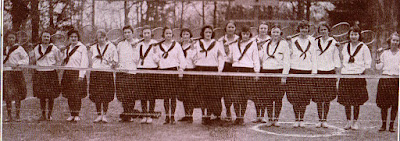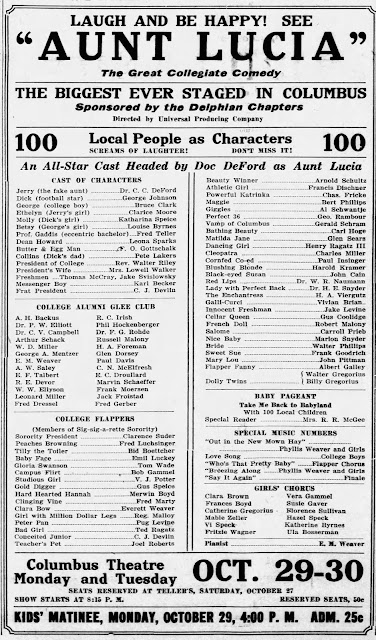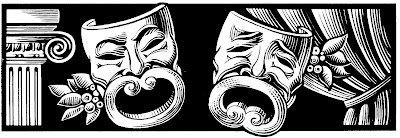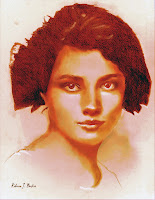 |
| Mary Ruth Norwood Portrait Sketch by Rebecca J. Becker |
In 1649 (less than three decades after the original Thanksgiving),
Henry Norwood fled England to seek safety in Virginia. His cousin, Sir
William Berkeley, was royal governor, and Henry was in real trouble.
He’d supported the king against the Roundheads - - and the king had, quite literally, lost his head. All royalists were at risk.
Norwood’s voyage was a disaster - - a nearly unbroken series of
horrific near-death encounters - - but he survived to write about the
journey in a celebrated narrative, A Voyage to Virginia.
(A few years later, Norwood became Treasurer of Virginia, a post he held for 12 years, before continuing his nearly unbelievable adventures - - including another flight, this time with a warlord and his harem in Tangiers!)
(A few years later, Norwood became Treasurer of Virginia, a post he held for 12 years, before continuing his nearly unbelievable adventures - - including another flight, this time with a warlord and his harem in Tangiers!)
270 years after Henry Norwood’s catastrophic voyage to America, Mary Ruth Norwood arrived at Crescent College.
She had every bit of her ancestor’s incredible courage and adventurous spirit. Her story is just as implausible as Henry’s - - but every word is true.
Before she came to Eureka Springs, Ruth (she very rarely used her full name) had been a student at a preparatory academy on the campus of Abilene’s Hardin-Simmons University.
We
don’t know, yet, what brought her to Crescent College, but once here she
had a very busy time indeed. Her focus was in Literary Studies, with a
second emphasis in French.
 |
| Ruth Norwood (second from left) at Crescent College Senior Vaudeville from the 1920 Crescent College yearbook |
But she was active in the Expression (theatre) Arts. You can see her here in two photographs from one production, the Senior Vaudeville: she’s second from the left in both,
 |
| Ruth Norwood (second from left) at Crescent College Senior Vaudeville from the 1920 Crescent College |
and performed in all of the college’s plays; she was a member of the Athletic Association,
a member of the Tennis Club,
the Riding Club, and the Hiking Club!
In 1919, everyone stayed at Crescent for Thanksgiving.
President Thompson held a feast for the entire faculty and all the
students. They described the evening:
“This was probably the most enjoyable occasion of the year, for the spirit of Thanksgiving certainly prevailed. Toasts were given by members of the faculty and student body. Then, to add more to the hilarity of the evening, Mr. Thompson entertained us with his clever stories. After the last course was served we passed into the ball room, where dancing began in full sway. And Thanksgiving was enjoyed to the fullest extent, by both the faculty and students.”
(Having a ballroom was an unusual, but often welcome, feature of Crescent College!)
In the 1920 yearbook, there are tantalizing glimpses of other sides to Ruth’s personality - - she (and her roommate, Sam “Sambo” Anita King)
Sam Anita King
from the 1920 Crescent College yearbook
|
were members of the Sins Club (we would love to discover more about this
club!), and the pair were also affectionately kidded on the Jokes page:
Ruth Norwood (to her room-mate): “Sambo, I wish you would illuminate some of those shoes from the closet.”
The two girls continued friends even after Ruth graduated from Crescent, and Sam visited Ruth in Abilene in 1921, when Ruth was enrolled as a student at Hardin-Simmons College.
(Crescent was a two-year college, and so after graduation, Ruth was able to begin her studies at H-S as a junior.)
J.D. Sandefer, president of Hardin-Simmons, offered Ruth the first of her many remarkable jobs, while she was still a student.
“Well,” she recalled years later, in an Abilene Reporter-News interview, “he saw me passing the campus one day and asked if I’d like to be the bursar at San Marcos Academy. I wasn’t sure what a bursar was, but I said yes.
“He said to catch the train at Buffalo Gap that
night; that they needed a good Christian girl down there. I did. It
turned out they’d had an administrative shakeup at San Marcos, it was
registration time and there was no bursar to take the money.
“I found out pretty quick I wasn’t a bookkeeper. So I secretly hired an accountant at Austin and would go to my sorority hall (Alpha Delta Pi) every weekend, with the books to balance. The accountant cost more than my wages.”
While still in her twenties, Ruth taught at
several schools, including St. Hilda’s Hall in Charleston, West
Virginia, and the Bon Avon School for Girls in San Antonio.
Her final academic position was as Principal in Ropesville, Texas.
But she’d been bitten by the theatre bug while at Crescent, and now a truly exceptional opportunity presented itself.
It all began with three brothers in Fairfield Iowa and their wild, revolutionary idea.
It sounds a bit like an old Judy Garland – Mickey Rooney movie: Hey, kids, let’s put on a show!
But that’s the seed of the idea - - multiplied by millions.
The brothers formed the Universal Producing Company, and trained a thousand directors who would then go out to every town, village and hamlet across the nation, armed with scripts, costumes, and a mission: to work with hundreds of locals to put on a play - - and then to split the proceeds from each performance.
(The local share of the proceeds usually went to charity, or to civic improvements, and townsfolk eagerly participated.)
 |
Local Talent in a Universal Producing Company production
in Buffalo Center, Iowa
|
The endeavor was such a success that Universal Producing Company became
“the largest live entertainment production company in the country for a
decade starting in the late 1920s.” [Fairfield Entrepreneur Hall of
Fame]
By the mid-1930s, the brothers were booking “ten shows
a weeknight across the nation, employed 225 coaches and a swarm of
salesmen….
Between 1928 and 1934 more than 1,000,000 amateur
actors appeared in casts of its productions which played to more than
6,000,000 people.” [The Pursuit of Knowledge Under Difficulties: From
Self-Improvement to Adult Education in America, 1750-1990 by Joseph F.
Kett, Stanford University Press.]
And most amazing of all?
Nearly all 1,000 directors and dramatic coaches employed by Universal Producing Company were young women!
Why do we never hear about this phenomenal enterprise?!
Ruth recalled, “They held a course in play directing for six weeks in the roof garden of the Jefferson Hotel in Dallas. They really made you do a fall if you’d been shot, or do a dance step. Goodness, if it had lasted longer, we worked so hard we’d have all been dead.”
Wilson Stewart, the brother
who ran the Universal Boot Camp, was described as “so charged with
dynamite, if he jarred himself he’d blow himself to bits….”
In addition to polishing her directing skills, Ruth also learned how to
“persuade people to be part of the shows, how to work with civic
organizations...”
By the end of six weeks, “coaches would have all the
skills of a teacher, preacher, salesman, dramatic coach, nursemaid and
governess, newspaper reporter, make-up artist, dance-hall queen,
sideshow barker and banker.” [Fairfield Entrepreneur Hall of Fame]
After Ruth finished Boot Camp, “they booked me in Downey, Idaho, and I
played all over Idaho until the snow got so deep we couldn’t.
“Next year, they transferred me to California. I enjoyed that, five
boat trips up and down the coast and all. I’d fly, too, and send the
costume trunks overland.” [This was in the very early 1930s, - -
flying was still quite an escapade!]
A poster from one of the Universal Producing Company’s shows, The World's All Right, is seen below.
You also see a map with the staggering number of productions around the country - - clearly demonstrating why this phenomenon needs to be recognized!
 |
| Universal Production Companies around the nation! |
After three years, Ruth decided to strike out on
her own. She produced her own show, Casey's Trial, using her knowledge
and experience at Universal to help her succeed - - a remarkable feat,
during some of the worst years of the Great Depression.
In fact, her opening production was in March, 1933 - - during President Franklin Delano Roosevelt’s famous Bank Holiday.
Ruth - - like her dashing ancestor, centuries before - - set out across
the world and mounted her first show in Persia (modern-day Iran), “while the oil boom was
on there.”
The show was an enormous success, and she then took the production around the United States.
Dozens and dozens of newspaper articles show her progress across the nation, with local citizens posing for promotional photographs with great gusto. There was even one production where the entire cast - - over 100 roles, male and female - - was male!
You see below a
photograph from Ada, Minnesota - - where (as in Columbus, Nebraska's production of Aunt Lucia,) the farming men are dressed as
flappers!
In 1937, she found herself in Tucumcari, New Mexico. She walked into the offices of the Tucumcari Daily News, where George H. Likins was editor.
It was her usual habit to try for free publicity, since the town would benefit from her production, but in Tucumcari, Likins refused.
“'We don’t give
anything away on this paper,’” Ruth recalled his declaring. “I guess we
went in before he’d had his morning coffee.”
Discouraged, she returned to her hotel room.
Later, “I picked up a paper and he’d devoted his whole column to our
show. I thought, ‘Well, I’ll just go back. His bark is worse than his
bite.’”
“We closed that show by getting married on Thanksgiving of 1937.”
Ruth and George shared many years together, and after a period when
they sold films for the Alexander Film Company, later owned and ran a
large motion picture theatre and a drive-in theatre in Abilene.
At one point, zoning and construction delays threatened their
operation, and they projected - - well, let Ruth explain, as she did in
this wry advertisement:
"Our live families like to eat.
Takes Money.
So we're showing on a sheet,
Big and funny."
George died in 1957, and Ruth closed the downtown theatre the next year.
In 1965, she was off on a new adventure, however - - traveling to England, to participate in the 750th anniversary signing of the Magna Carta.
In 1965, she was off on a new adventure, however - - traveling to England, to participate in the 750th anniversary signing of the Magna Carta.
 |
| Postage stamp from Great Britain Celebrating the Magna Carta |
Another of her ancestors, Robert Fitz-Walter,
 | ||||
| Seal of Lord Robert Fitz Walter, who led the opposition against King John of England |
was one of the barons responsible for King John's signing the original.
Ruth died in 1979, and is buried with George in Abilene. They had no
children, but if you or anyone you know is related to her - - or to any
of the Crescent College students or faculty - - please, do get in touch!
We’d love to hear from you!




























































